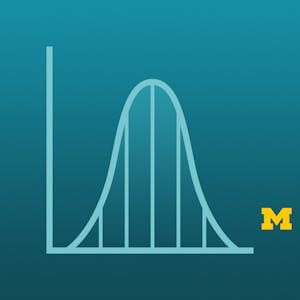Understanding and Visualizing Data with Python
In this course, learners will be introduced to the field of statistics, including where data come from, study design, data management, and exploring and visualizing data. Learners will identify different types of data, and learn how to visualize, analyze, and interpret summaries for both univariate and multivariate data. Learners will also be introduced to the differences between probability and non-probability sampling from larger populations, the idea of how sample estimates vary, and how inferences can be made about larger populations based on probability sampling.At the end of each week, learners will apply the statistical concepts they’ve learned using Python within the course environment. During these lab-based sessions, learners will discover the different uses of Python as a tool, including the Numpy, Pandas, Statsmodels, Matplotlib, and Seaborn libraries. Tutorial videos are provided to walk learners through the creation of visualizations and data management, all within Python. This course utilizes the Jupyter Notebook environment within Coursera.
Properly identify various data types and understand the different uses for each
Create data visualizations and numerical summaries with Python
Communicate statistical ideas clearly and concisely to a broad audience
Identify appropriate analytic techniques for probability and non-probability samples
Syllabus
Syllabus - What you will learn from this course
Week 1
WEEK 1 - INTRODUCTION TO DATA
Week 2
WEEK 2 - UNIVARIATE DATA
Week 3
WEEK 3 - MULTIVARIATE DATA
Week 4
WEEK 4 - POPULATIONS AND SAMPLES
FAQ
When will I have access to the lectures and assignments?
Access to lectures and assignments depends on your type of enrollment. If you take a course in audit mode, you will be able to see most course materials for free. To access graded assignments and to earn a Certificate, you will need to purchase the Certificate experience, during or after your audit. If you don't see the audit option:
What will I get if I subscribe to this Specialization?
When you enroll in the course, you get access to all of the courses in the Specialization, and you earn a certificate when you complete the work. Your electronic Certificate will be added to your Accomplishments page - from there, you can print your Certificate or add it to your LinkedIn profile. If you only want to read and view the course content, you can audit the course for free.
What is the refund policy?
If you subscribed, you get a 7-day free trial during which you can cancel at no penalty. After that, we don’t give refunds, but you can cancel your subscription at any time. See our full refund policy.
Is financial aid available?
Yes. In select learning programs, you can apply for financial aid or a scholarship if you can’t afford the enrollment fee. If fin aid or scholarship is available for your learning program selection, you’ll find a link to apply on the description page.
Reviews
The course itself was good. I think I learnt the specific concepts well. However, I would have to go through the general sense of python to actually implement what I learnt here
20 studying hours that helps me getting back to speed on manipulating the quantitative data in Pandas with different query conditions, powerful statistics and Sampling Distributions.
Well organized material. The Discussion forum was the best one I've experienced in my Coursera education. All my questions were answered within one day. The best statistics class I've taken yet!
Great course to learn the basics! The supplementary material in Jupyter notebooks is extremely valuable. Really appreciate the PhD students who took the time to explain even the simplest of codes :)
